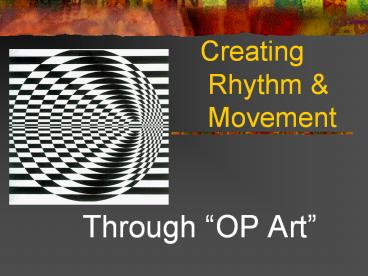Creating Rhythm - PowerPoint PPT Presentation
Title:
Creating Rhythm
Description:
Rhythm is a word we are familiar with when we think of subjects such as music ... Brittney, 8th grade, Fish tessellation, Cut paper and markers, 9 x 9' Movement ... – PowerPoint PPT presentation
Number of Views:973
Avg rating:3.0/5.0
Title: Creating Rhythm
1
Creating Rhythm Movement
- Through OP Art
2
Rhythm
- Rhythm is a word we are familiar with when we
think of subjects such as music and dance. You
might think of it as the drum beat to a song, the
clapping of hands or even the tapping noise
created by dancers on the floor. Words such as
beat, tempo or pulsing may come to mind. These
are examples of rhythms we hear. Now think of
what rhythm means to a visual artist.
3
Rhythm Is One of the Principles of Design
- To an artist, rhythm shows movement through the
artists' repetition of certain elements of art.
Just as in music when a beat is repeated over and
over, an artist will use an element of art such
as color and repeat it over and over in a work of
art. Let's look at an example.
- Brittney, 8th grade, Fish tessellation,
- Cut paper and markers, 9 x 9"
4
Movement
Movement is another very important Principle of
Design. Perhaps you are thinking that artworks as
a rule do not actually move. You are correct, but
we are talking about visual movement. Artists
know that if certain Elements Of Art are used to
create a Rhythm, there will be visual movement.
The viewer's eye is drawn from one object to the
next as they appear over and over in a piece of
work. Let's take a look at an example.
5
Vincent Van Gogh, (Dutch) 1853-1890, Starry
Night, 1889, Oil on CanvasMuseum of Modern Art,
NY
6
Creating Rhythm Movement Through OP Art
Bridget Riley, Blaze 4, 1964 Bridget Riley,
Movement in Squares, 1964
7
What is Op Art anyway?
Optical Art is generally characterized by
hard-edged black and white patterns or geometric
shapes which use repetition of simple forms and
colors to create vibrating effects.
8
OP Art
- The birth of op art began officially with an
article in time magazine. In 1964, Time magazine
published an article featuring an art movement
involving optical illusions. Since the artists
focused on eye manipulation, Time magazine coined
this new movement op art.
9
Father of Op Art
Vasarely is hailed as the inventor and father of
optical art. The breakthrough brought by his
"kinetic" experiments transformed the flat
surface into a world of unending possibilities,
way before the advent of computers, book marking
an era in the history of art in general.
Victor Vasarely 1906-1997
10
Female OP Artist
- Artists like Bridget Riley (Born, 1931)
understood that the human eye has trouble looking
at certain color combinations and line
combinations. In fact, if you stare at them long
enough, the images actually appear to move or
vibrate.
Bridget Riley, 1964
Bridget Riley, 1982
11
Get Ready to create your own OP-ART
You will create your own OP-Art designs that
will use both rhythm and movement based on the
ideas of Riley Vasarely.
Finished! Op Art Design in the style of
Bridget Riley.













![❤[PDF]⚡ The Visual Story, Second Edition: Creating the Visual Structure of Film, TV PowerPoint PPT Presentation](https://s3.amazonaws.com/images.powershow.com/10061181.th0.jpg?_=20240621069)

















